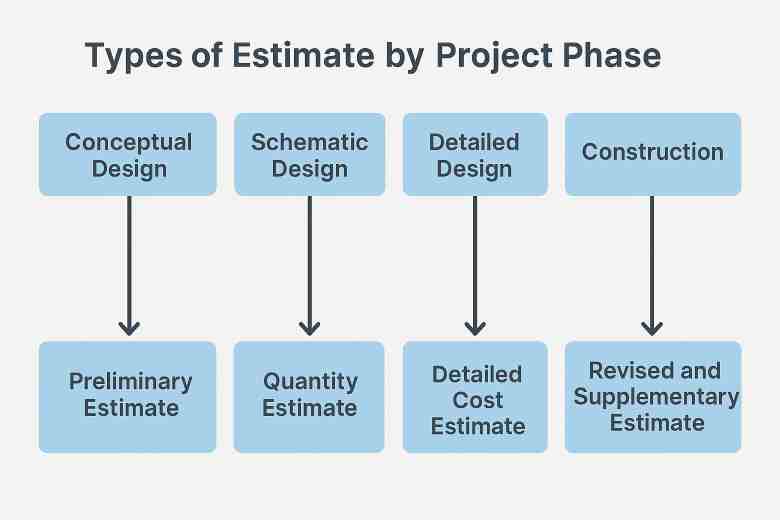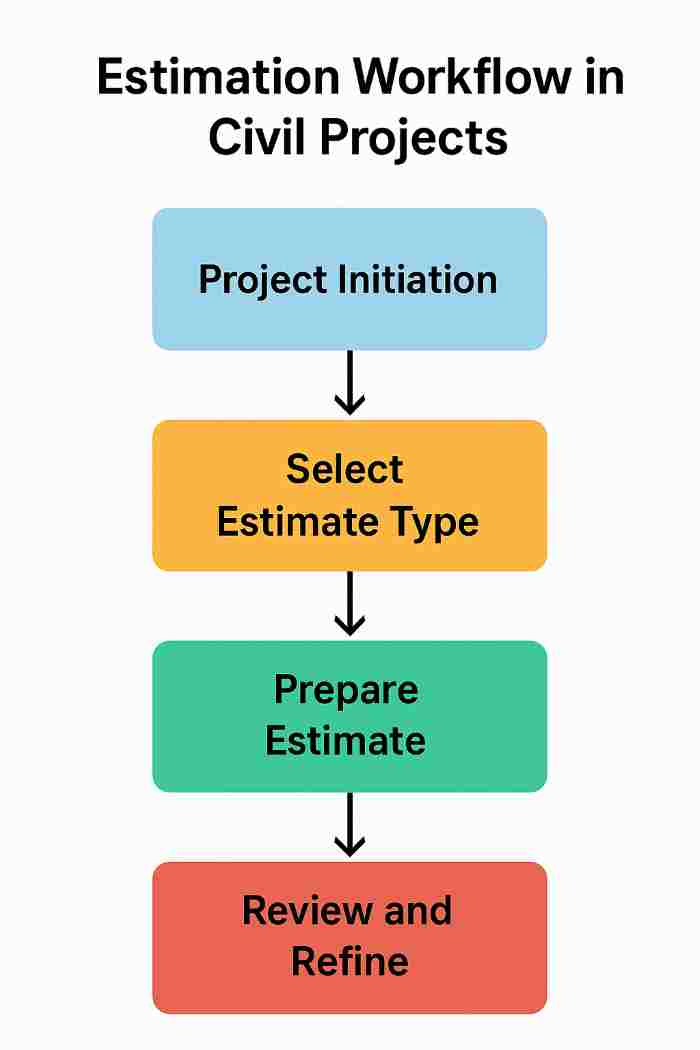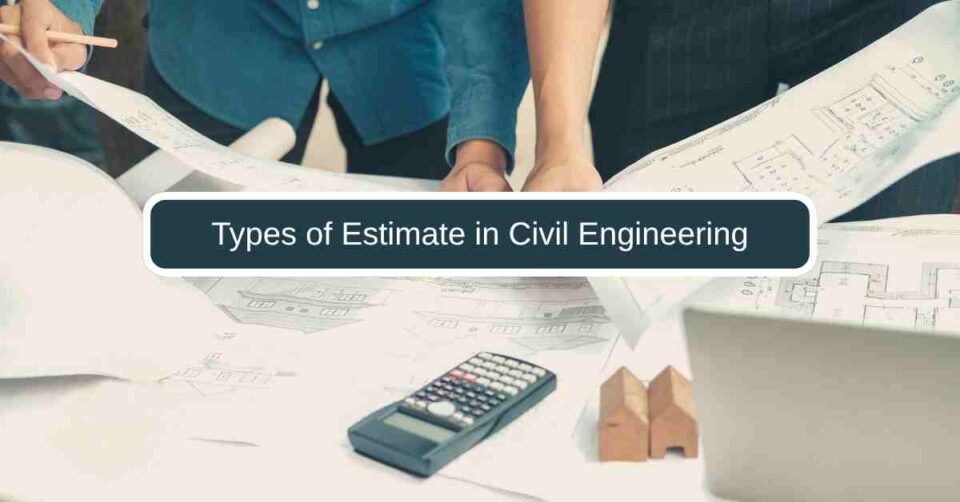Last Updated on July 4, 2025 by Admin
Understanding the types of estimate in civil engineering is essential for project success, whether you’re a seasoned professional, a student, or a construction manager. Accurate estimation helps control costs, minimize risks, and streamline project planning from concept to completion. In this updated 2025 guide, discover the key types of estimates, when to use each, and how modern methods are reshaping the industry—empowering you to make smarter, data-driven decisions in every phase of your civil engineering projects.
ConstructionCareerHub App is LIVE — built ONLY for construction careers. Don’t apply with a weak resume.
Get ATS-ready Resume Lab + Interview Copilot + Campus Placement Prep (resume screening, skill gaps, interview readiness) — in minutes & Other advanced features.
Explore Smarter Construction Career Tools →Quick check. Big impact. Start now.
Table of Contents
Why Estimates Matter in Civil Engineering
Imagine launching a bridge, a high-rise, or a metro project without knowing the cost or resources required. Unthinkable, right? In the world of civil engineering, estimation is the foundation on which all successful projects are built.
Whether you’re a site engineer, project manager, student, or public works official, mastering the different types of estimates in civil engineering is crucial. Not only does it help control costs and prevent overruns, but it also builds trust with clients, secures funding, and ensures regulatory compliance.
In this guide, you’ll discover:
- The various estimate types every civil professional must know
- When and why each type is used
- Best practices, challenges, and real-world examples from top projects
What Is Estimation in Civil Engineering?
Estimation in civil engineering is the process of forecasting the probable quantities and costs of materials, labor, plant, and equipment needed to complete a project as designed. A good estimate is not just a “number”—it’s a comprehensive, documented prediction that shapes project feasibility, funding, design, and construction strategies.
Why It’s More Than Just Math
A successful estimator blends technical knowledge, historical data, site experience, and foresight—balancing accuracy and practicality.
“Estimation is both an art and a science—requiring deep knowledge of construction methods, market trends, and project risk.” — American Society of Civil Engineers (ASCE)
Why Are Estimates Essential in Construction Projects?
The importance of types of estimate in civil engineering cannot be overstated. Estimates are vital for:
-
Budget Approval: Securing funds from clients, banks, or government bodies.
-
Design Development: Refining project scope, specifications, and engineering solutions.
-
Bid Preparation: Allowing contractors to quote competitively and confidently.
-
Cost Control: Monitoring spending and avoiding costly overruns.
-
Resource Planning: Ensuring timely procurement and scheduling of labor, materials, and equipment.
Fact: According to a 2024 KPMG global survey, over 70% of major projects exceed their initial budgets—often due to poor estimation and scope creep.
🚀 Pro Tips for Accurate Estimation in Civil Engineering
- Maintain a Cost Database: Always update and refer to a cost database from past projects—this dramatically improves the speed and accuracy of early estimates.
- Leverage Technology: Use BIM and estimation software for automatic quantity take-offs and live rate updates.
- Document Assumptions: Clearly record all your assumptions and sources to avoid disputes and confusion later.
- Include Contingency Judiciously: Add realistic contingency (typically 5–15%)—not too little, not too much.
- Cross-Check with Benchmarks: Before finalizing, compare your estimate with similar completed projects for a “sanity check.”
Key Principles of Construction Cost Estimation
Before diving into the types, let’s anchor ourselves with a few estimation principles:
-
Accuracy vs. Effort: Early estimates are fast but rough; later ones are detailed but time-intensive.
-
Scope Clarity: Clearer design and scope enable more precise estimates.
-
Contingency: Smart estimates include contingencies for unknowns (usually 5-15%).
-
Documentation: Every assumption, source, and calculation must be traceable.
Pro Tip: Always keep historical data and past project records—they are gold mines for future estimation!
Regional Estimation Standards: India, US, GCC, and Beyond
Construction estimation practices and standards can vary significantly depending on the region, reflecting local regulations, industry norms, and market conditions.
-
India:
Estimation typically follows guidelines set by the Central Public Works Department (CPWD) or state PWDs, using the Schedule of Rates (SOR) and standards published by government agencies. Detailed estimates are often mandatory for public sector projects, and regional plinth area rates are frequently referenced. -
United States:
Estimation standards often align with the Construction Specifications Institute (CSI) MasterFormat, ASTM standards, and AACE International classifications. There is heavy emphasis on bid-based and unit price estimation, with robust use of software and digital tools. -
Gulf Cooperation Council (GCC) Countries:
Estimation tends to follow FIDIC contracts and local codes. The market is influenced by international consultants, with a mix of British, American, and regional approaches. Labour/material cost data is tailored to the expat-driven construction workforce and fluctuating supply chains. -
Europe, Australia, Others:
Many regions have local estimation standards (e.g., SMM7/RICS in the UK), but globalization is encouraging convergence in methods, especially for multinational projects.
Tip: Always align your estimate methodology and documentation with the regulatory standards of your project location to ensure compliance and client confidence.
Related Posts:
- What is Estimation and Costing in Civil Engineering?
- 10 Important Things To Be Included In A Construction Estimate
- Estimation Engineer Career Guide [2025 Updated]
- The Pros and Cons of Using Estimating Software for Construction Projects
- 150 Interview Questions and Answers on Construction Estimating and Cost Control
Major Types of Estimate in Civil Engineering
Civil projects move from concept to completion in phases, and each phase demands a specific estimate. Here’s an authoritative breakdown of the main types of estimate in civil engineering:
1. Preliminary Estimate (Approximate Estimate)
What Is It?
A preliminary estimate (or approximate estimate) is a quick, high-level forecast of project costs prepared at the concept or feasibility stage. It’s based on broad measurements and typical rates rather than detailed plans.
When Is It Used?
-
Early project discussions
-
Budget approvals
-
Investment decisions
How Is It Calculated?
-
By multiplying key project parameters (e.g., built-up area, length of road) with standard rates from previous, similar projects.
Example:
If a new 20,000 sq.ft. office building typically costs $1,200/sq.ft., then the preliminary estimate = 20,000 x $1,200 = $24 million.
Advantages:
-
Quick and low-cost
-
Enables go/no-go decisions early
Limitations:
-
Less accurate (can be ±30%)
-
Does not account for project-specific complexities
Use-Case:
When a city authority is considering a new bridge, a preliminary estimate helps compare it to other capital projects for funding.
2. Plinth Area Estimate
What Is It?
A plinth area estimate is based on the covered built-up area (plinth area) of a building, including walls, at the floor level.
When Is It Used?
-
Government buildings
-
Public infrastructure
How Is It Calculated?
-
Plinth Area (in sq.m. or sq.ft.) × Plinth Area Rate (derived from past projects in the region)
Example:
A school building with a plinth area of 2,500 sq.m. and a local plinth area rate of ₹25,000/sq.m. = ₹62,500,000.
Advantages:
-
More specific than a preliminary estimate
-
Good for standard structures
Limitations:
-
Ignores floor heights, finishes, and services
Cube Rate Estimate
What Is It?
A cube rate estimate uses the total building volume (in cubic meters or feet) instead of area. It’s especially useful for multi-story buildings where heights vary.
When Is It Used?
-
High-rise apartments
-
Commercial towers
How Is It Calculated?
-
Volume × Cube Rate (from similar projects)
Example:
If the cube rate is $650/m³ and the building volume is 6,000 m³, then estimated cost = $3.9 million.
4. Detailed Estimate (Quantity Estimate)
What Is It?
The detailed cost estimate in civil engineering is a thorough, item-by-item calculation based on actual drawings, specifications, and quantity take-offs.
When Is It Used?
-
Final design phase
-
Tendering/bidding
-
Construction planning
How Is It Calculated?
-
Take-off of all quantities (concrete, steel, bricks, finishes, etc.) from drawings
-
Apply current market rates for each item
Example Table: Sample Quantity Estimate for a 1,000 sq.m. Building
| Item | Quantity | Rate | Amount |
|---|---|---|---|
| Concrete (m³) | 400 | $110/m³ | $44,000 |
| Steel (kg) | 35,000 | $1.2/kg | $42,000 |
| Brickwork (m³) | 120 | $90/m³ | $10,800 |
-
High accuracy (±5-10%)
-
Basis for contracts and billing
Limitations:
-
Time-consuming and requires complete design data
Use-Case:
Large infrastructure like highways, where contractors submit detailed estimates for competitive bidding.
5. Revised Estimate
What Is It?
A revised estimate is prepared when the cost of a project exceeds the original approved estimate by a certain percentage (commonly 5% or more).
When Is It Used?
-
Design changes
-
Price escalation
-
Major scope revisions
How Is It Calculated?
-
Based on updated drawings, specifications, or market rates
Example:
If an original road project estimate was ₹10 crore, but new regulations require additional safety features, a revised estimate would reflect the updated cost (say, ₹12 crore).
6. Supplementary Estimate
What Is It?
A supplementary estimate is an add-on to the original estimate for additional works or unforeseen circumstances.
When Is It Used?
-
Extra amenities (e.g., landscaping)
-
Scope expansions during execution
Example:
A hospital project adds a parking structure mid-way, needing a supplementary estimate.
7. Annual Repair Estimate
What Is It?
Prepared for routine annual maintenance and minor repairs of existing structures.
Example:
Municipal bodies use this for budgeting maintenance of schools, roads, etc.
8. Supplementary and Revised Estimate
A combined estimate used when both additional work and significant cost overrun occur.
9. Other Specialized Estimates
-
Valuation Estimate: For buying/selling property.
-
Salvage Value Estimate: For demolition projects.
-
Technical Sanction Estimate: For government approvals.

Estimation in Modern Project Delivery Models
Civil engineering projects are increasingly delivered through innovative contracting models, each influencing estimation strategy:
-
EPC (Engineering, Procurement, Construction):
The contractor is responsible for all project phases, so the estimate must be exhaustive, covering engineering, procurement, and construction risks. Lump-sum EPC contracts demand highly accurate, fixed-price estimates with built-in contingencies for contractor risk. -
PPP (Public-Private Partnership):
Estimation includes not only construction costs but also long-term operation, maintenance, and financing. Lifecycle cost analysis and value-for-money studies are essential, and estimates must often meet stringent government audit and transparency requirements. -
Design-Build:
The designer and builder collaborate under a single contract. Estimates evolve as design progresses, with initial conceptual estimates refined into detailed pricing. Fast-tracking and design overlaps demand agile estimation methods and close design–cost integration.
For modern delivery models, early engagement of estimators, use of BIM, and dynamic cost modeling are best practices to manage risks and maintain project profitability.
Classes of Construction Cost Estimates
In global best practice, cost estimate classes (AACE International, ANSI) define the accuracy and detail at each project stage.
| Estimate Class | Definition | Typical Accuracy | Project Phase |
|---|---|---|---|
| Class 5 | Order of Magnitude | -50% to +100% | Early concept/feasibility |
| Class 4 | Conceptual/Schematic | -30% to +50% | Pre-design |
| Class 3 | Budgetary/Design | -20% to +30% | Design development |
| Class 2 | Definitive | -15% to +20% | Detailed design |
| Class 1 | Control | -10% to +15% | Construction/Execution |
Source: AACE International
Step-by-Step: How Are Estimates Prepared?
-
Define Project Scope: Review drawings, specifications, and site conditions.
-
Quantity Take-off: Measure quantities of all work items.
-
Apply Rates: Use current market rates or schedule of rates.
-
Add Overheads and Profits: Contractor’s margin, taxes, insurances.
-
Include Contingencies: Account for unknowns.
-
Document and Review: Record every assumption and double-check calculations.

Modern Tools and Technologies in Estimation
Civil engineering estimation is embracing digital transformation:
-
BIM (Building Information Modeling): Allows 3D quantity take-offs directly from digital models.
-
Estimation Software: Examples include CostOS, Candy, and PlanSwift.
-
AI and Data Analytics: Predict cost trends and automate historical data analysis.
Example: Read more about BIM in construction on ConstructionPlacements.com.
Try Our Interactive Construction Estimate Calculator
Curious about your project costs? Use our real-time Construction Estimate Calculator below to get an instant idea based on your inputs.
*Tip: Enter your project details to see a live estimate and better understand the concepts discussed above.*
Case Studies: Estimates in Real-World Projects
Case Study 1: Highway Expansion in India
A 2023 NHAI highway project saw the preliminary estimate pegged at ₹900 crore. As design progressed, the detailed estimate increased to ₹1,040 crore due to new bridge requirements and rising material costs, triggering a revised estimate for stakeholder approval.
Case Study 2: Hospital Construction in UAE
A major UAE hospital began with a plinth area estimate. When design innovations (modular patient rooms, smart sensors) were introduced, the team used detailed estimates from BIM models to ensure budgets remained accurate—saving 7% through value engineering.
Case Study 3: Renovation of Heritage Buildings
A supplementary estimate was required mid-way when conservationists demanded period-accurate materials, increasing cost but preserving cultural value.
Common Challenges in Civil Engineering Estimates
-
Unpredictable Material Prices: Volatility in steel, cement, and fuel can upend estimates.
-
Incomplete Designs: Early estimates often rely on rough sketches.
-
Site Risks: Unexpected ground conditions or weather events.
-
Regulatory Changes: New codes or standards mid-project.
Stat: According to McKinsey, poor estimation and risk management cost the global construction industry up to $1.6 trillion annually.
⚠️ Common Pitfalls in Estimation
- Overlooking Scope Changes: Failing to update estimates after design or scope changes leads to major cost overruns.
- Ignoring Local Market Fluctuations: Using outdated material/labor rates from other regions can make your estimate unreliable.
- Inadequate Documentation: Not recording the basis of your estimate causes confusion and disputes during audits.
- Underestimating Contingency: Skipping or underestimating contingency can leave you exposed to unexpected costs.
- Neglecting Site Conditions: Not accounting for unique site conditions (soil, accessibility, weather) can seriously skew estimates.
Best Practices for Accurate Estimation
-
Use Updated Data: Reference recent market rates and completed projects.
-
Apply Contingencies Judiciously: Avoid both under- and over-estimating.
-
Benchmark with Similar Projects: Historical cost data is invaluable.
-
Leverage Technology: Adopt BIM and estimation software.
-
Collaborate Across Teams: Engage designers, engineers, and procurement early.
-
Document Assumptions: Transparency prevents disputes.
-
Regularly Review and Revise Estimates: Especially for long-duration projects.
Related Posts:
FAQs: People Also Ask
Q1. What are the different types of estimates in civil engineering?
Civil engineering uses multiple estimate types to suit project needs and stages: preliminary estimate (initial cost idea), plinth area estimate (based on built-up area), cube rate estimate (per volume), detailed estimate (item-wise and highly accurate), revised estimate (when cost escalates), supplementary estimate (for additional works), and specialized estimates (for MEP or landscape elements).
Q2. What is a detailed cost estimate in civil engineering?
A detailed estimate is a comprehensive calculation involving all quantities and unit costs of materials, labor, equipment, and contingencies. It is based on approved drawings and specifications, ensuring accurate budgeting and contract finalization.
Q3. When should a revised estimate be prepared in a construction project?
A revised estimate is prepared when the original sanctioned cost is likely to be exceeded by more than 5–10%, usually due to changes in project scope, material costs, or updated regulations. It ensures transparency and administrative approval before further spending.
Q4. What are cost estimate classes in construction?
Cost estimate classes range from Class 5 (Order of Magnitude) with ±50% accuracy for early concept stages, to Class 1 (Definitive or Control Estimate) with ±10% or better accuracy, used just before execution. These classifications help match estimate detail with project stage.
Q5. How can technology improve the accuracy of civil engineering estimates?
Tools like Building Information Modeling (BIM), AI-powered quantity take-off software, and cloud-based cost databases (e.g., RSMeans, CostOS) reduce errors, integrate real-time updates, and enhance decision-making during both planning and execution.
Conclusion & Next Steps
Mastering the types of estimate in civil engineering is essential for everyone in the construction sector—from students to senior project managers. Accurate estimation isn’t just a technical skill—it’s a strategic advantage. It improves project outcomes, builds trust, and protects your professional reputation.
Ready to take the next step?
-
Explore advanced cost estimation and budgeting resources.
-
Browse our technical resources for tools, guides, and latest industry insights.
-
Comment below: What estimation challenges do you face? Let’s build better, together!
References & Further Reading
- AACE International: Cost Estimate Classification System
- KPMG 2024 Global Construction Survey
- McKinsey: The Construction Industry’s Productivity Problem
- ASCE: Estimation Guidelines
- ConstructionPlacements.com: Civil Engineering Guides


